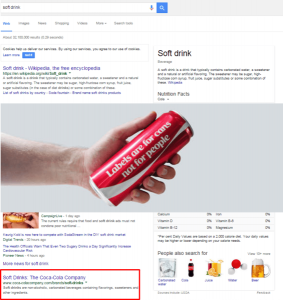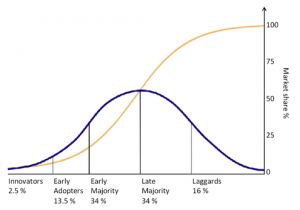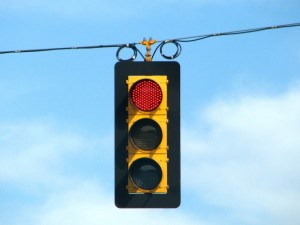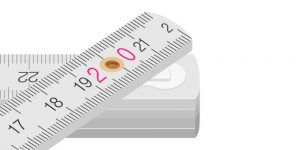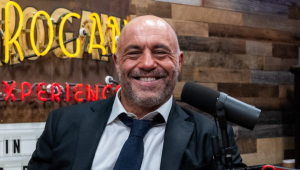
Just as a journey of a thousand miles begins with a single step, the journey of a buyer begins with a single problem.
And being there to answer that problem can be the beginning of a relationship that eventually results in a brand new customer.
But in order to convert that customer, you’ll first need to understand who they are and how they’re approaching a problem.
This process of educating your users through different stages of a problem, eventually resulting in a purchase, is known as a buyer’s journey.
A buyer’s journey consists of three main stages:
- Awareness
- Consideration
- Decision
The way in which you’ll communicate with your audience will change based on which stage of the buyer’s journey they’re in.
For example, in the awareness stage, users might not even know the specific name of the problem they’re having. Initially they might just know that their “microwave is making funny noises”.
After a little bit of research online, they might discover that their microwave has a problem with its exhaust fan. At this time they might search for something like “fixing microwave exhaust fan”.
After a little more digging they come to the conclusion that fixing that exhaust fan is too challenging for themselves so they enlist the help of a professional. At this time, they might search for a “microwave technician in San Francisco”.
Notice how the user progressively becomes more educated about the source of their problem until the point where they actively seek out a solution?
Understanding these steps can help you create targeted content aimed at helping users get to a final purchase decision. If you’re curious how this can be done, this guide is designed to walk you through the stages of a buyer’s journey, and how it can help you generate more customers.
Note: The length and type of content associated with a buyer’s journey will fluctuate from industry to industry and between different types of businesses. This article is meant to give you an overview of the buyer’s journey framework rather than focusing on a specific business or industry.
Buyer’s Journey Stage 1: Awareness
At the beginning of the buyer’s journey, it’s unlikely that a buyer has any idea about what your company is, what you offer, and how it can benefit them. All they know is that they have an issue that needs exploring, whether that be a “creaky patio door” or that their “cell phone that is slow.”
This is called the awareness stage. During this phase buyers are experimenting with different search terms or looking for clues about what their problem might entail. They might also be searching for potential opportunities or researching something that they’re curious in online.
During the awareness stage, it’s important to create content that is informational and not overly promotional.
Examples of awareness stage search queries might include:
- “Best places to travel”
- “How to prevent water from leaking from the sink”
- “How often to service a car”
- “How to market online”
In each of these examples, there is an implied problem or opportunity present, but the buyer has not yet articulated what that is yet.
Try to avoid mentioning your business at all during this stage and focus on instead answering typical questions that an early stage customer might have. When creating content, try and use headlines and keyphrases in line with what that buyer would be searching for. In some cases that might involve removing some industry jargon, or phrasing your questions and answers in a different way.
Here’s an example of an awareness stage piece of content from Trip Advisor, when a user searches for “best places to travel”.

Notice how the content focuses on giving readers a broad overview of some of their different travel options while not asking them to book a trip right away?
That’s because at this stage buyers might not be planning on travelling to a specific destination at all. They’re still researching and learning about their different options which will eventually contribute to their final decision to travel.
Once buyers are more informed about some of their different options only then will they start to focus their attention on finding information about a specific travel destination
While it’s not recommended to link to products from this stage of content, it is possible to use non intrustive popups and forms to capture lead data which can allow you to nurture and target your prospects as they make their way through your buyer’s journey.
Buyer’s Journey Stage 2: Consideration
Once a buyer becomes a little more educated about what they’re looking for they can start to dig a bit deeper into which solution would fit them best.
At this stage your buyer will have a clear idea of what they’re looking for and will be looking for a product or service to meet that need.
Example of consideration stage queries might include:
- “Cheap flights to Hawaii”
- “List of Vancouver plumbers”
- “Reliable car cabin filter”
- “Best autoresponder software”
- “Guide to Facebook Ads”
Notice how consideration stage queries are much more focused on finding a specific answer rather than exploring a general subject area?
In the consideration stage, buyers want to see as much as they can about their various options and how they can be used. Things like expert guides, targeted webinars, product pages, and comparison charts can all be used in this stage.
While your aim is not to go for the sale during this stage of the buyer’s journey, you can start to capture contact information a little more aggressively using landing pages and social promotions.
Gating content such as ebooks, how to guides, and webinars is another great way of educating buyers while simultaneously collecting lead data.
Here’s an example of a consideration stage piece of content from Wishpond. In it we describe a number of ways to best use Facebook ads.

Notice how Wishpond is barely mentioned on this landing page as well as throughout the book?
That’s because buyers are looking for specific information regarding Facebook Ads, not necessarily a platform to do so.
The important thing to remember during this phase of the buyer’s journey is that prospective buyers are open to your product or service, but still aren’t ready to pull the trigger. Understanding this fact will help you keep your content educational while keeping your call to actions less sales oriented.
Buyer’s Journey Stage 3: Decision
Once buyers have a clear idea of exactly what they’re looking for, it’s time to convince them that your company is the best option for them.
This can be accomplished through things like:
- Product pages
- Use-cases
- Live demos
- Case studies
- Customer success stories
- Product comparisons
- Product reviews
- Support documentation
In the decision stage users are looking for information on how your product works, how others like them have been successful, and how their experience might be if they decide to go forward with your company.
Don’t be afraid to toot your own horn a little during the decision stage. After all, no one ever wanted to enlist the services of “An Alright Real Estate Agent”.
Also remember to present information in a way that’s appealing to the key decision maker. That might mean creating downloadable PDF case studies rather than having them available on your website, or speaking in terms of “ROI” rather than “encouraging engagement”.
Take a look at this decision stage content from Hootsuite. In this case study they clearly outline how a similar company was able to achieve amazing results, and they even include a call to action at the end prompting users to get started or request a demo.

Notice how they succinctly describe the core results on the right hand side of the page? Depending on the product or service that you’re selling, if team members need to get approval before making a purchase, they’re going to need to run it by a decision maker to make that happen.
Since that decision maker would likely not have been exposed to your awareness and consideration stage content, it’s important to make it as simple as possible for them to quickly and easy see the value that you’ll bring.
Buyer’s Journey Stage 4: Post-Purchase
Once a buyer makes a purchase, that doesn’t mean that their buyer’s journey is over. Oftentimes buyers will spend time reading up on support documentation and implementation guides as they become acquainted with your product.
During this time it’s important to have relevant and useful information available to ensure that you give your new clients the best possible experience.
One trick to help buyers in this stage is to set up onboarding email drip campaigns designed to send helpful tips to people just starting out.
Emails can include:
- Welcome emails
- FAQ guides
- Best practices
- Invitations to attend demos or webinars
- Links to blog posts or other support documentation
Remember, it can be up to 6 – 7 times more expensive to obtain a new customer then it is to retain an existing one. Spend time to provide a good onboarding experience for your new customers and watch it pay dividends down the road.
Wrapping up
Understanding your buyer’s journey is one of the core components of creating a good content strategy. Knowing what people are looking for, and at which stage of the buyer’s journey they’re in can help your content team create more targeted content, with more effective calls to actions.
Remember that depending on your business a buyer’s journey can span from days, to weeks, and possibly months. During this time buyers will likely view content from a number of different sources and on a number of different devices.
Take a look at this breakdown of a buyer’s journey for a travel website. In it we can see how a buyer ended up having 380 web page engagements over the course of 2 months with 87% of those touchpoints happening on mobile.

Given that we know that a buyer’s journey can span long periods of time (while often overlapping with the buyer’s journey of other businesses), creating the right content, in the right format, delivered at the right time, can make all the difference in the world.
Digital & Social Articles on Business 2 Community(78)
Report Post
